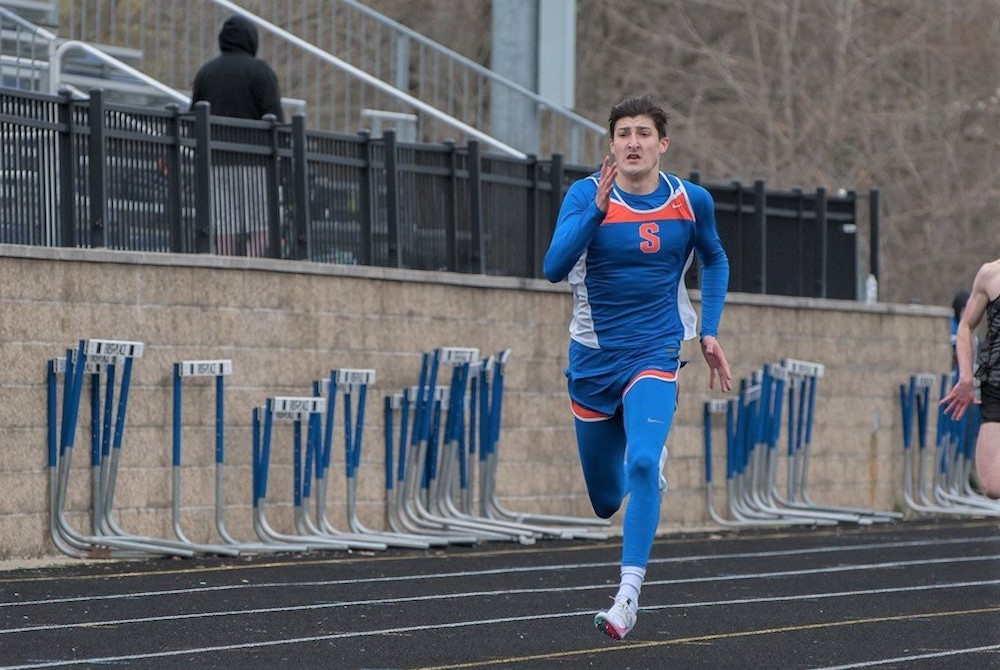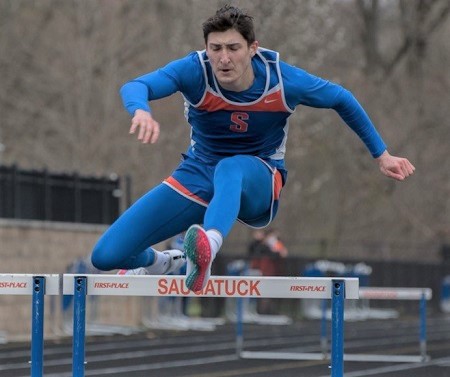
Saugatuck Speedster Aiming for Historic Performance
By
Dean Holzwarth
Special for MHSAA.com
May 12, 2021
SAUGATUCK -- Saugatuck boys track & field coach Rick Bauer frequently tosses out a nickname for one of his elite runners.
 Benny “The Jet” Diaz, a junior sprinter, has definitely lived up to the moniker.
Benny “The Jet” Diaz, a junior sprinter, has definitely lived up to the moniker.
“I don’t remember who gave me that nickname, but coach Bauer uses it a lot,” Diaz said. “I don’t mind it, and it refers to Benny and the Jets or from the movie Sandlot.”
Wherever it came from, it fits, as Diaz has turned up the jets this spring on the track and blossomed into one of the fastest runners and hurdlers in the state.
Whether it’s in the sprints (100, 200 or 400 meters) or the hurdles (110 and 300), Diaz possesses blazing speed and athleticism.
“He’s fast, and he was born with some talent for sprinting, but his real talent is just how hard he works at it,” Bauer said. “I don’t think people understand that this is a 365-day thing for Benny and his dad working on speed.”
As a freshman, Diaz placed third in the 300 hurdles at the MHSAA Division 4 Finals and helped his team place second overall.
He worked hard for another opportunity to shine in his sophomore season, but it was wiped out due to COVID-19.
“It was pretty tough, and just not being able to compete was not fun,” Diaz said.
Diaz would have to wait another year, and now his training and intense drive to succeed is coming to fruition.
Entering this week, Diaz has posted the fifth-fastest time in the state in the 100 after running a personal-best 10.85 seconds at last week’s Shepherd Invitational.
He’s ranked No. 2 in the 110 hurdles (14.86) and in the top 20 in the 200 dash and 300 hurdles.
For Diaz, who also excels in football and baseball, track was somewhat of an afterthought before learning of his potential.
“In sixth grade it was something to fill my time and get faster for football and baseball,” he said. “But once I was in middle school, I started seeing results and it just became more fun and I was getting better every meet.
“I started doing indoor track and competed in the winter and spring and started getting a lot better. It’s become a job a little bit to try and get myself faster, stronger and better throughout the season.”
Diaz’s dad, Mario, has been instrumental in his son’s success. He also serves as the team’s sprint coach.
 “He’s definitely helped by pushing me, and we study some things together,” Diaz said. “How to get a better block start, and how to strengthen my legs to get quicker and explosive. He spends a lot of his time with me working on those kinds of things, so I’m pretty appreciative of him.”
“He’s definitely helped by pushing me, and we study some things together,” Diaz said. “How to get a better block start, and how to strengthen my legs to get quicker and explosive. He spends a lot of his time with me working on those kinds of things, so I’m pretty appreciative of him.”
Diaz also travels outside of the area and state to compete in various events.
He thrives off the challenges he faces from racing against runners with similar abilities.
“It’s been fun going up against better competition,” Diaz said. “I run faster with competition because sometimes always winning isn’t too fun. Competition is always fun, even if you lose sometimes, and it’s just still fun going up against people who are the same or better.”
While Diaz simply enjoys competing, some events stand out from the others.
“The 200 is fun because I can come off the curve and just run people down,” he said. “I go past them and then separate on the straightaway. The 100 has been good to me, running under 11 (seconds), and the 400 is fun, but it hurts.”
Diaz has lofty goals for this year’s Finals, which will take place June 5 in Hudsonville.
The only decision now is deciding which events he’s going to run.
“It’s no secret what we’re going after,” Bauer said. “He wants to win four individual events, and that’s what we’re going to try and do.
“It’s just a matter of which events he’s going to do. Everyone has their own opinions, but we’re getting there. It’s a major goal to try and win four, so let’s do something that very few have done.”
Only eight athletes – and only two from the Lower Peninsula – have won four individual events at an MHSAA Boys Track & Field Finals.
Said Diaz: “I want to win all four of my events, and we will try to figure out what’s best to get all 40 points and get the best times I can before summer track.”
 Dean Holzwarth has covered primarily high school sports for Grand Rapids-based WOOD-TV for four years after serving at the Grand Rapids Press and MLive for 16 years along with shorter stints at the Ionia Sentinel and WZZM. Contact him at [email protected] with story ideas for Allegan, Kent and Ottawa counties.
Dean Holzwarth has covered primarily high school sports for Grand Rapids-based WOOD-TV for four years after serving at the Grand Rapids Press and MLive for 16 years along with shorter stints at the Ionia Sentinel and WZZM. Contact him at [email protected] with story ideas for Allegan, Kent and Ottawa counties.
PHOTOS: (Top) Saugatuck's Benny Diaz outpaces the competition in a sprint during a recent meet. (Middle) Diaz also excels at both hurdles races. (Photos by Dean Holzwarth.)

Hastings Relays Reigns as State's Oldest Continuous Track & Field Meet
By
Steve Vedder
Special for MHSAA.com
April 10, 2024
Bob Branch remembers dabbling in other sports, but his first love was always running.
 The Hastings High School graduate admits he could never hit a baseball, football didn't especially appeal to him and basketball was just another way to spend time with friends. But for Branch, now 93, there was always track. That's the sport where his fondest and sharpest memories remain. And if you're talking track, many of his favorite memories come from participation in the state's oldest continuous track meet, the Hastings Relays.
The Hastings High School graduate admits he could never hit a baseball, football didn't especially appeal to him and basketball was just another way to spend time with friends. But for Branch, now 93, there was always track. That's the sport where his fondest and sharpest memories remain. And if you're talking track, many of his favorite memories come from participation in the state's oldest continuous track meet, the Hastings Relays.
Always held in early April, the meet dates back to 1937 – a bygone time that saw the first hostilities of World War II, gas at 20 cents a gallon and a loaf of bread selling for a dime.
And at a dusty old track surrounding the county fairgrounds in Hastings, a small relay event that included a scattering of participants from a dozen high schools was taking its first tentative steps.
Branch recalls a time when kids would run home after track practice because there were no buses, inexperienced young coaches had little actual knowledge of running fundamentals, and athletes looked at the sport as an afterthought after spending most of their high school days playing football and basketball.
 For Branch, the relays were the ideal way to ease into the track season.
For Branch, the relays were the ideal way to ease into the track season.
"I just liked to run," said Branch. "I remember I anchored a relay with my brother, and it always seemed cold when we had that meet. I remember teams would come from all over and you saw a lot of good athletes. Everybody seemed to have someone who was really good. Track wasn't very popular at that time, but I have a lot of good memories from running."
The Hastings Relays, which has changed formats and even names during its nearly nine-decade history, would traditionally kick off the track season. The meet was originally held at a makeshift quarter-mile track which surrounded the town's fairgrounds and was part of the city's annual Hastings Carnival – the track would become the midway during fair time.
The meet eventually moved to Johnson Field when the football field was dedicated in 1949 and ballooned to as many as 50 teams at its peak in 1957. For more than seven decades it was known as the Hastings Relays and then the Hastings Co-Ed relays before becoming the current Hastings Invitational, with the latest edition scheduled for Friday.
Johnson Field had a cinder track before it became an all-weather surface in the 1980s. During a time long before computers would be used to organize meet heats in mere minutes, Hastings coaches of all sports – defined as "volunteers" by the athletic department – would meet on the Friday before competition to hash out events.
People associated with the meet still recall the camaraderie built on those long Friday nights, followed by working what would often become 10-hour meets. Steve Hoke has been involved since watching his father, Jack, who coached teams at 15 of the meets beginning in 1951 and also had run in the first Hastings Relays. Steve Hoke later competed in the Relays as well during the early 1970s before becoming an assistant track coach, later the Hastings athletic director and now a volunteer worker.
"It was always a huge deal," said Hoke, who said the meet began as a pure relay event before transitioning to its current team format in the 1990s. "I remember we'd line the track the night before, and all the coaches would come to the house to organize everything. There was a brotherhood.”
 If you quiz many of the fleet of volunteers who've worked the relays over the years, each has a different memory from the meet. While Hoke describes the brotherhood and Branch the outstanding competition, others remember weather and the time a thunderstorm wiped out the line markings on the cinder track, or waking up to find three inches of snow that caused a rare cancellation of the meet. Others recall the shock of moving from the cinder to all-weather track or using the meet as an early measuring stick of what it would take to qualify for the state meet. The real old-timers remember the meet disappearing for three years during World War II.
If you quiz many of the fleet of volunteers who've worked the relays over the years, each has a different memory from the meet. While Hoke describes the brotherhood and Branch the outstanding competition, others remember weather and the time a thunderstorm wiped out the line markings on the cinder track, or waking up to find three inches of snow that caused a rare cancellation of the meet. Others recall the shock of moving from the cinder to all-weather track or using the meet as an early measuring stick of what it would take to qualify for the state meet. The real old-timers remember the meet disappearing for three years during World War II.
Hastings native and Western Michigan grad Tom Duits was the state’s second collegian to break the four-minute mile when he ran a 3:59.2 at a meet in Philadelphia in 1978. Duits, who ran in three Hastings Relays, was in line to join the U.S. Olympic team in 1980 before the United States pulled out of the games due to tension with Russia.
Duits has his own memories of the meet and the competition he faced there.
"I remember sunshine and being excited to be competing again. There were all these athletes swarming around; it was an awesome display of talent," he said. "It was always one of the best meets we'd be in. You could pretty much see the level of runners who would be at state, which made it a big deal. It was always early, but you could tell where you stood. It was great exposure."
Hastings track star Wayne Oom competed in four Hastings Relays from 1984-87. One of his sharpest memories was the difference between running on a raw cinder track versus the far more comfortable all-weather surface.
"Those cinders would grind into your skin," said Oom, part of the Hastings school record in the two-mile relay. "But I think it helped us because when we'd go to other tracks, it seemed we would run faster. I remember how competitive it was, especially in the distances. There were some great runners."
While participants have their unique memories, so do coaches. Former Saxons coach Paul Fulmer remembers 2008 when his team finished first on the boys side of the meet while his wife, Grand Haven coach Katie Kowalczyk-Fulmer, saw her girls team win the championship.
 "I knew we were one of the favorites to win because we were usually near the top of our conference and Regional," he said. "But then Katie's team was pretty good, and it was cool for them to win too."
"I knew we were one of the favorites to win because we were usually near the top of our conference and Regional," he said. "But then Katie's team was pretty good, and it was cool for them to win too."
Fulmer, who coached Hastings from 1978-81 and then 1985-2010, said at least part of the meet's popularity was derived from a unique way of scoring. Instead of individuals earning points solo, participants worked in pairs. For instance, two athletes would combine their shot put or long jump scores. New events such as the 1,500 relay and sprint medley were added.
"We had a tradition of being the state's oldest meet, and that was a big deal," Fulmer said. "And we ran a good relay; that attracted teams too. We took a lot of pride in that.
"And we'd get quite a lot of people to come to the meet. We'd set up until like 9 or 10 p.m., and then we'd have a party with all the coaches on Friday night."
While the meet has stretched 87 years, Branch said early participants and current runners have one thing in common: a drive to win. Branch ran in an era when the popularity of high school track was in its infancy. Today some of the best all-around athletes at a school are involved in the track program. The relays span the nearly nine decades in between.
"The quality of teams has gotten better and better," said Branch, the 1947 Lower Peninsula Class B Finals champ in the 220. "And this has made for a better meet. We would get guys who played football or baseball kind of drift into track, and that made the sport better. I think people began to appreciate track because we'd get teams from all over.
"We went from not really knowing what we were doing to track being a good sport. Even then, I'm not sure we appreciated what we had. We really liked the Hastings Relays and always wanted to do well there. It became popular and quite an honor to do well. Those are the kind of things I remember."
PHOTOS (Top) Racers run at the Hastings Relays, with several more awaiting their turns to compete at the longtime meet. (2) The author wrote on the 50th anniversary of the Relays for the Hastings Banner nearly 40 years ago. (3) Past athlete, coach and athletic director Steve Hoke shows some of the Relays awards from the 1930s. (4) Tom Duits was one of the state’s biggest track stars of the 1970s and ran in three Hastings Relays. (Top photo by Dan Goggins, Hoke photo provided by Steve Hoke and Duits photos provided by Tom Duits.)

